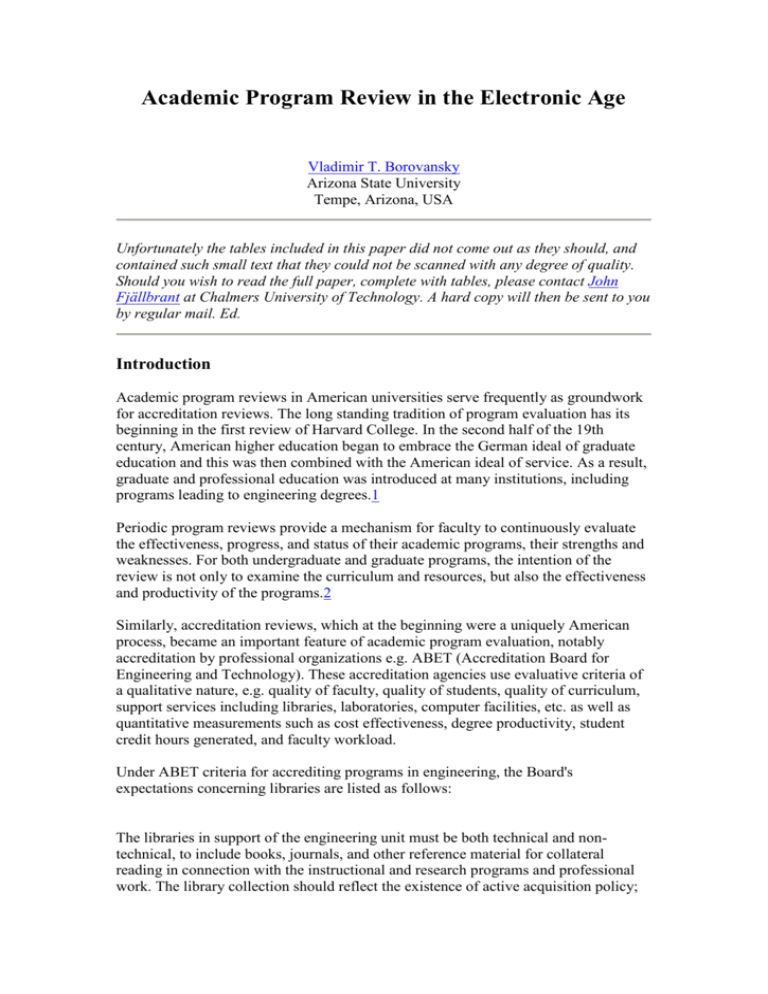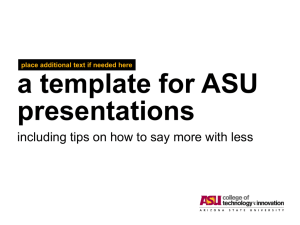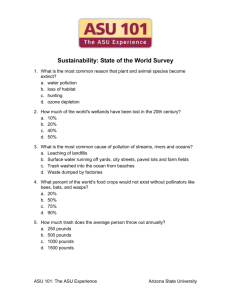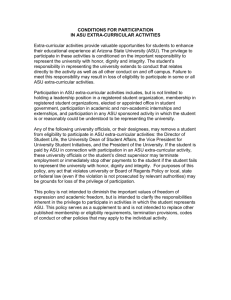Academic Program Review in the Electronic Age
advertisement

Academic Program Review in the Electronic Age Vladimir T. Borovansky Arizona State University Tempe, Arizona, USA Unfortunately the tables included in this paper did not come out as they should, and contained such small text that they could not be scanned with any degree of quality. Should you wish to read the full paper, complete with tables, please contact John Fjällbrant at Chalmers University of Technology. A hard copy will then be sent to you by regular mail. Ed. Introduction Academic program reviews in American universities serve frequently as groundwork for accreditation reviews. The long standing tradition of program evaluation has its beginning in the first review of Harvard College. In the second half of the 19th century, American higher education began to embrace the German ideal of graduate education and this was then combined with the American ideal of service. As a result, graduate and professional education was introduced at many institutions, including programs leading to engineering degrees.1 Periodic program reviews provide a mechanism for faculty to continuously evaluate the effectiveness, progress, and status of their academic programs, their strengths and weaknesses. For both undergraduate and graduate programs, the intention of the review is not only to examine the curriculum and resources, but also the effectiveness and productivity of the programs.2 Similarly, accreditation reviews, which at the beginning were a uniquely American process, became an important feature of academic program evaluation, notably accreditation by professional organizations e.g. ABET (Accreditation Board for Engineering and Technology). These accreditation agencies use evaluative criteria of a qualitative nature, e.g. quality of faculty, quality of students, quality of curriculum, support services including libraries, laboratories, computer facilities, etc. as well as quantitative measurements such as cost effectiveness, degree productivity, student credit hours generated, and faculty workload. Under ABET criteria for accrediting programs in engineering, the Board's expectations concerning libraries are listed as follows: The libraries in support of the engineering unit must be both technical and nontechnical, to include books, journals, and other reference material for collateral reading in connection with the instructional and research programs and professional work. The library collection should reflect the existence of active acquisition policy; this policy should include specific acquisitions on the request and recommendation of the faculty of the engineering unit. While the library collection should be reasonably complete and should go well beyond the minimum collection required for use by students in specialized programs, there should be in existence such arrangements as are necessary for computer-accessible information centers and inter-library loan services for both books and journals. The library collection, whether centralized or decentralized, should be readily available for use with the assistance of a trained library staff, or through an open-stack arrangement, or both. The ultimate test of a library is the use made of it by students and faculty. Use of the library depends on many factors including opening and closing hours, reading room space, availability and helpfulness of the staff, and accessibility of material.3 Collection Evaluation Collection assessment for the accreditation of an entire discipline, e.g. mechanical engineering, can be satisfied by using standard tools like the North American Title Count (NATC)4 and OCLC/Amigos Collection Analysis CD (CACD)5 These tools usually compare the entire LC class, in this case "TJ" against other peer institutions, aspirational peers, indicating growth of collection, collection concentration and percentage of local collection which is sufficient in addition to other required standards for the purpose of accreditation. The academic program review on a graduate, in particular, a doctoral degree level shall have higher expectations. In this paper, an assessment of library holdings and services for the Science and Engineering of Materials Interdisciplinary Doctoral Program at ASU is presented. To analyze this program, both traditional as well as electronic tools were used. Tools Used The first used were the traditional tools for collection evaluation, the North American Title Count (NATC)4, formerly known as National Shelflist Count, and a variety of printed sources, including publishers' catalogs and blurbs, citations in relevant publications, mainly major monographs, conference publications, advanced texts, latest reference works reflecting the program clients' interest. The North American Title Count (NATC) 1993 and 1985 NATC is a nationwide cooperative effort to determine the number of titles held by 57 academic libraries in specific Library of Congress classification divisions. However, these classifications are rather broad (e.g. the TA classification covers general and civil engineering which also includes TA 401 - 492 materials of engineering and construction, or the entire TK class covering electrical engineering and electronics). The libraries are divided into three groups, based on their total titles reported, preceded always by the Library of Congress. The methodology of this tool allows for counting unique titles in the size of the collection, combining monographs and serials. Because the project is conducted at varying intervals, it also serves as a measure of growth of collections over the years. Finally, it shows also collection concentration, as percentage of local collection as well as relative concentration vis-a-vis other collections. These traditional tools were complemented in some cases by searching OPACs of our peer institutions as well as the web sites of some unique fields highly relevant to our program, e.g. the Foresight Institute for nanotechnology information sources. The use of bibliographies from recent major monographs deserve special mention since they aided in a better assessment of these special disciplines relevant to the SEM interdisciplinary program. The definition of monograph (expanded from the ALA's one) - being "a comprehensive survey of current knowledge on a narrowly defined topic, including a literature survey, written by authors who are authorities in their disciplines" - signifies that their bibliographies can serve as relevant checklists of information sources in particular disciplines. In addition to these traditional tools, two electronic tools were used for the assessment of the interdisciplinary doctoral program. The first was the OCLC/AMIGOS Collection Analysis CD (CACD) database, the second was the University Science Indicators on Diskette (USIOD) 1981-1995. The OCLC/AMIGOS Collection Analysis CD (CACD) allows us to compare our acquisition program for a ten year period (1984-1994) with various peer groups also including our peers and aspirational peers. The most prestigious group, ARL first quartile, is the top eighteen members of the Association of Research Libraries (including UCLA, UofA, Uof Wisconsin-Madison and Ohio State). The 2nd quartile is the next largest group of 20 members and includes ASU. ASU holdings can also be compared separately with the holdings of UofA. (Tables 4-6) The columns should be read as follows: Titles are number of titles added during the ten year period. Evaluator means Arizona State University. Avg Mbr refers to the average member of the peer group named above. Comparative size means the relative size of ASU's collection compared with the average member. Pct of Subcollection indicates the percentage of the collection represented by this particular Library of Congress class. Peer Group indicates the percentage of the peer group's collection represented by the class. Evaluator indicates the percentage of ASU's collection represented by this class. University Science Indicators on Diskette(USIOD)6 is a database of summary publication and citation statistics that reflects research performance of U.S. universities in a number of scientific fields. These fields correspond to ISI's present Current Contents categories. The database contains counts of publications and citations taken from peer-review journals (over 5,000 in the sciences) indexed by ISI from 1981 to 1995. ISI chose a group of more than 100 U.S. universities from among those that have received the largest amount of federal spending. The principle used in this coverage strategy is based on "Bradford's Law of Scattering". This law asserts that a relatively small group of journals will account for the large majority of important and influential research in a given field. Results To put the assessment of the library collections and information support for the Science and Engineering of Materials interdisci- plinary program at ASU into perspective, comparisons have been made with library collections, their growth, concentration etc. with two groups of universities. These were ASU College of Engineering and Applied Sciences' peers and aspirational peers. Peer Universities: University of Arizona University of New Mexico University of Iowa Washington State University Aspirational Peers: University of California, Los Angeles University of Washington Ohio State University University of Wisconsin-Madison North American Title Count (NATC) A comparison between ASU and its peers showed that the library collections in the physical sciences and engineering compare favorably not only with the peers (UA, UNM) but in some cases with aspirational peers as well, e.g. TA LC class. Also, it should be mentioned that ASU and its College of Engineering are relatively new (established 1958) as compared to some of our aspirational peers whose collections are sometimes only a little larger. (Tables 1-3) OCLC/AMIGOS Collection Analysis CD (CACD) Comparisons in using this tool were made against our peer sister institution University of Arizona, against the ARL 1st quartile of 18 largest academic libraries (which include UCLA, UW-M, Ohio State, UWA and again the UA)and against the ARL 2nd quartile which includes ASU and the 23rd second largest university libraries. University of Iowa, Washington State and University of New Mexico are not listed. Using "Subcollection Proportions" report gives simple percentages that compare the size of your collection in a range of NATC classes within one Library of Congress classification division, with the corresponding portion of the combined collection of the selected peer group and with the collection of an average peer group member. In Table 4 comparing ASU against our sister institution, our collections fare quite well. In Table 5 ASU fares very favorably when compared with average member, in comparison size and percentage of subcollection. In Table 6, ASU compared with 23 libraries of approximately the same size (but not necessarily peers in the science and engineering of materials disciplines)and far exceeded the average member's collection size and other factors. Monographic Bibliographies Citations from bibliographies in a discipline is sometimes the only way to assess a fast moving field such as science and engineering of materials. The comparison of bibliographies in selected mono- graphs revealed that ASU Libraries have considerable collections strength in the physical sciences and engineering areas relevant to the SEM interdisciplinary doctoral program. Sample pages of selected recently published monographs and conference proceedings with bibliographies indicate that in most instances ASU holds between 81 and 91 percent of relevant titles. (Tables 7-9) University Science Indicators (USIOD) This database was also used for evaluating the specific field "materials science" since it is one of the narrower fields covered. Use of this tool showed that the research activities of the ASU SEM interdisciplinary doctoral program have made considerable progress in the last several years and in some types of analysis have even surpassed its aspirational peers. (Tables 10-12) Conclusions Academic program reviews are comprehensive and generally more thoughtful than accreditation reviews. A program review is an occasion for giving concentrated thought to developing and maintaining real excellence in academic program. Academic library support is an inseparable part of this process and the librarians will strive to provide their clients with the best information support and service in the traditional as well as electronic format. REFERENCES 1. CONRAD, Clifton F. and WILSON, Richard F. Academic Program Reviews: Institutional Approaches, Expectations and Controversies. ASHE-ERIC Higher Education Report No. 5. Washington, D.C. Association for the Study of Higher Education, 1985, 96p. 2. Academic Program Reviews. Policies and Procedures. Graduate College. Arizona State University, Tempe, AZ. 1995, 30p. 3. GARTEN, Edward D., ed. The Challenge and Practice of Academic Accreditation: a Sourcebook for Library Administrators. Westport, CT, Greenwood Press, 1994, 285p. 4. North American Title Count: Titles Classified by Library of Congress and NLM Classifications. Chicago, IL, American Library Association, 1994, 770p. 5. OCLC/AMIGOS Collection Analysis CD. User Guide. 2nd ed. Dublin, OH, OCLC, 1993, 53p. 6. Institution for Scientific Information. University Science Indicators on Diskette, 1981-1995. A database of summary publication and citation statistics reflecting research performance in the sciences and social sciences. Version 1.3, Summer 1996. Philadelphia, PA, ISI, 1996, 21p. ADDITIONAL READING 1. SACKS, Patricia Ann. Preparing for Accreditation: a Handbook for Academic Librarians. Chicago, American Library Association, 1993, 84p. 2. HALL, Blaine H. Collection Assessment Manual for College and University Libraries. Phoenix, AZ, Oryx Press, 1985, 212p.







